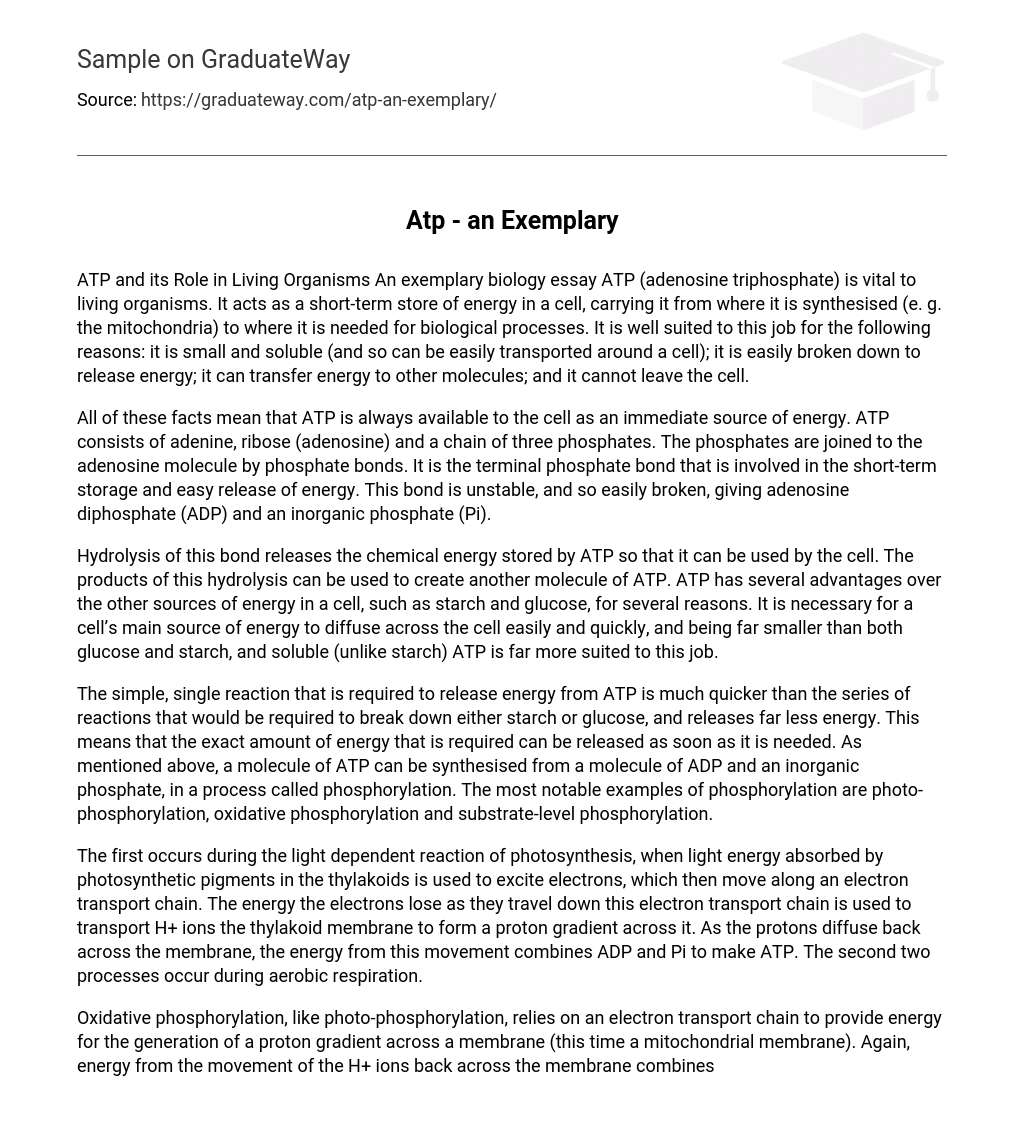ATP and its Role in Living Organisms An exemplary biology essay ATP (adenosine triphosphate) is vital to living organisms. It acts as a short-term store of energy in a cell, carrying it from where it is synthesised (e. g. the mitochondria) to where it is needed for biological processes. It is well suited to this job for the following reasons: it is small and soluble (and so can be easily transported around a cell); it is easily broken down to release energy; it can transfer energy to other molecules; and it cannot leave the cell.
All of these facts mean that ATP is always available to the cell as an immediate source of energy. ATP consists of adenine, ribose (adenosine) and a chain of three phosphates. The phosphates are joined to the adenosine molecule by phosphate bonds. It is the terminal phosphate bond that is involved in the short-term storage and easy release of energy. This bond is unstable, and so easily broken, giving adenosine diphosphate (ADP) and an inorganic phosphate (Pi).
Hydrolysis of this bond releases the chemical energy stored by ATP so that it can be used by the cell. The products of this hydrolysis can be used to create another molecule of ATP. ATP has several advantages over the other sources of energy in a cell, such as starch and glucose, for several reasons. It is necessary for a cell’s main source of energy to diffuse across the cell easily and quickly, and being far smaller than both glucose and starch, and soluble (unlike starch) ATP is far more suited to this job.
The simple, single reaction that is required to release energy from ATP is much quicker than the series of reactions that would be required to break down either starch or glucose, and releases far less energy. This means that the exact amount of energy that is required can be released as soon as it is needed. As mentioned above, a molecule of ATP can be synthesised from a molecule of ADP and an inorganic phosphate, in a process called phosphorylation. The most notable examples of phosphorylation are photo-phosphorylation, oxidative phosphorylation and substrate-level phosphorylation.
The first occurs during the light dependent reaction of photosynthesis, when light energy absorbed by photosynthetic pigments in the thylakoids is used to excite electrons, which then move along an electron transport chain. The energy the electrons lose as they travel down this electron transport chain is used to transport H+ ions the thylakoid membrane to form a proton gradient across it. As the protons diffuse back across the membrane, the energy from this movement combines ADP and Pi to make ATP. The second two processes occur during aerobic respiration.
Oxidative phosphorylation, like photo-phosphorylation, relies on an electron transport chain to provide energy for the generation of a proton gradient across a membrane (this time a mitochondrial membrane). Again, energy from the movement of the H+ ions back across the membrane combines ADP and Pi. An example of substrate-level phosphorylation is the oxidation of triose phosphate during glycolysis, which provides the energy required to phosphorylate two molecules of ADP. ATP acts as an energy source for many biological processes, among them metabolism (i. . the creation of macromolecules from smaller molecules), active transport, the maintenance, repair and division of cells and organelles, the production of substances used within organisms, and muscle contraction. For example, during muscle contraction, ATP is required to move the globular heads on myosin filaments, which pull the actin filaments along, and to break the actin-myosin cross bridges that form so that this “rowing” action can continue. This shortens the sarcomeres that make up muscle tissue, causing the muscle to contract.
During active transport, ATP provides the energy required to change the conformation of the carrier proteins that transport certain molecules across a cell membrane against their concentration gradient. In conclusion, ATP (which is generated during photosynthesis and respiration) plays a vital role in living organisms, as described above. Although there are other stores and sources of energy, ATP is the best suited to its role as an immediate source of energy. Without ATP, energy for certain biological processes would not be provided quickly enough, or in the correct volumes. Thus, without ATP, life as we know it would not exist.





